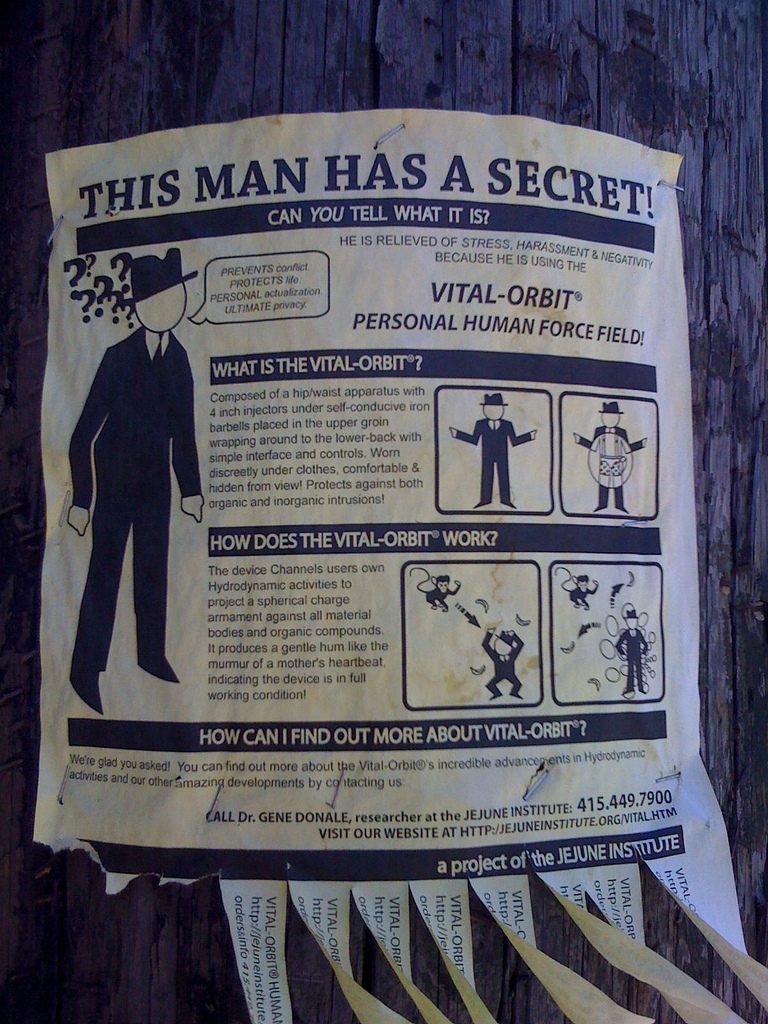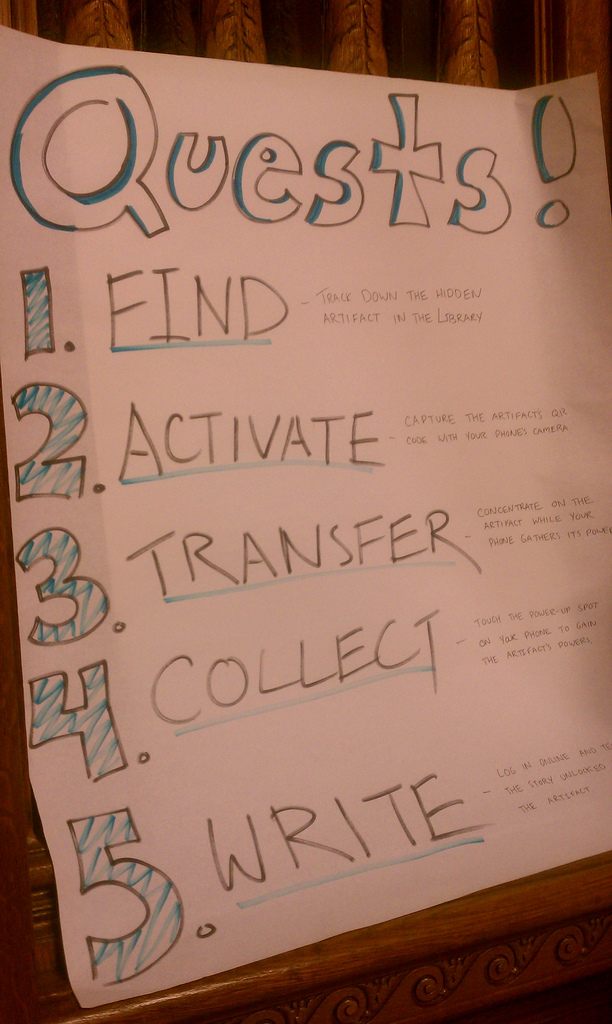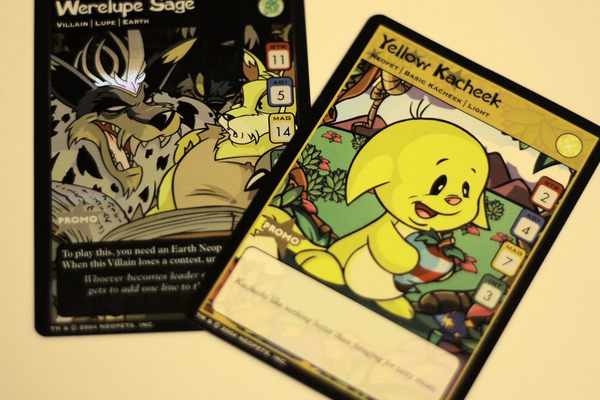Alternate Reality Games Could Still Take Over the World (And Your Life)

Is a robot about to call and threaten your life? (Photo: David D/flickr)
Something big is coming up on September 22. Or September 27, when there will be a lunar eclipse. Or October 8, timed to the Draconid meteor shower. You don’t know what it is, but it definitely has to do with a man named Callum Felderi and the mysterious company that employs him.
When Callum Felderi added you on Facebook, he was mostly vaguebooking about the game he was working on and a girl who dumped him. But then he posted a puzzle, a word search full of items like “conundrum” and “problem” and “baffle.” When you solved it, he sent you a message: “You are someone I can trust, it seems. Or at least rely on for intelligence and ability… CAN you help me? My friend is missing, Lucy Lime.”
Then a friend of Callum’s posted a picture with a hidden URL that led to a site playing a Morse code message, which turned out to be a message encoded with the Vigenere alphabet substitution cipher. You found a 1997 Simon Armitage play about an eclipse with a character named Lucy Lime. Before you knew it, you were applying for a job at Callum’s mysterious company, the 88. Now, his most recent code has led to a poem about “king dragons” and “all dreams will be death flooded” that you think refers to something happening on September 22. Or September 27. Or October 8.
Of course, it’s all a game. The poems and plays and astronomical phenomena are real, but Callum and Lucy are characters played by a “puppet master,” and Callum’s original message was what’s known as a “trailhead,” an invitation to participate in a quest that’s part riddle, part research project, and part collaborative fiction. His Facebook page, his company website, Lucy’s disappearance—they’re all made up, but Callum will never admit it, even if you ask. Welcome to the alternate reality game, or ARG.
ARGs aren’t virtual reality games; they take place in the real world, and they often require no tools except for the internet and maybe a phone. They’re not augmented reality games, where a phone app (for example) reveals hidden digital elements in real-world locations. They’re more like living in a novel. Any time you want, you can add a little thrill to your normal life; these are puzzles and mysteries that are careful fictions, but that masquerade as real-life intrigue.
“I think most of [the appeal of ARGs] is the feeling that the world around you is more magical than it might at first appear,” says Andrea Phillips, an ARG designer who was also an avid player. “That you could turn a corner and find a stranger with a secret that could help you save the world, or click a link and open a door into another place and another life. It imbues the whole rest of your world with more possibility, more chances to be amazed. Like stepping inside a storybook.”

A trailhead for the Jejune Institute. (Photo: Cooper/flickr)
Before the definitive ARG, The Beast, debuted in 2001, there were already a few games that blurred the line between play and real life. From the early days of the internet (and, indeed, before the internet, though it’s harder to track), there were communities inventing Slenderman-style urban legends and collaborative fictions. Roleplaying games, including live-action roleplaying games, started in the 1970s, and had players take on a specific persona for the duration of the game. But the Beast was clearly something different; some of the storytelling aspects of legend-creation, some of the pervasiveness of LARP, but unbounded and not always under players’ control. It inserted itself into your real life almost without asking.
“The first time The Beast called people, one of the in-character websites (the ‘Anti-Robot Militia’) had a form where you could type in your phone number, without really explaining what would happen,” says Dan Fabulich, also a game designer and Beast player. “It seems obvious in hindsight, but they actually called the number. (They claimed to be a robot who had stolen the ARM’s files, and warned that dire consequences would follow.) I tell you, the first time a robot called me at home to threaten my life, I was totally hooked.”
Yet, even as millions more people have access to the digital tools to find and spread such games, it seems that there are fewer ARGs happening than in the past. (Of course, there’s no way to check the number of ARGs in the world; they are, by nature, fleeting and mysterious.) Callum Felderi is one of a handful being actively discussed on the ARG-focused “Unforum.” Other Unforum discussions mention possible ARG trailheads, but discussion peters out; the leads turn out to be spurious or uninteresting or the game folds for lack of funds. One of the posts on Reddit’s /r/ARG/ says plaintively, “I found this ARG 18 days ago. I’m the only one playing still.” A “new to ARGs, need help” post has zero comments.
But in the 2000s, when companies were blundering into virtual reality as the next great business and marketing front, a lot of them were trying to find their way into alternate reality as well. The vast majority of well-known ARGs were promoting something; in fact, in many ways it’s a uniquely promotional art form, born in capitalism. The Beast was a tie-in with Steven Spielberg’s movie A.I. 2004’s I Love Bees, which had tens of thousands of participants solving puzzles online and running out to answer pay phones for more clues, was a promotion for the video game Halo 2. Audi had an ARG, revolving around a stolen car. So did Nine Inch Nails, McDonald’s, a whole host of TV shows from Alias to Numb3rs, and Windows Vista.
 Notes from I Love Bees. The coordinates turned out to be pay phones. (Photo: Cory Doctorow/flickr)
Notes from I Love Bees. The coordinates turned out to be pay phones. (Photo: Cory Doctorow/flickr)
One ARG-style puzzle actually outlived the television show it was meant to advertise. ABC mystery show Push, Nevada debuted in 2002, when ARGs were brand new, and each episode offered a clue that would combine to help viewers win a $1,045,000 prize. There were 13 such clues—but there were only seven episodes. The show was abruptly canceled, and the final six clues were crammed into the last aired episode all at once. (To the showrunners’ credit, they still awarded the prize.)
There have been self-supporting ARGs, some of them quite ingenious in their plans to pay for themselves. The clothing brand edoc laundry, for instance, seeded every t-shirt design with a hidden message that would lead to an online video offering clues to a murder mystery. British ARG Perplex City sold collectible puzzle cards that, when solved, allowed players to advance within the game. But an ARG like I Love Bees—which involved, among other things, coordinated calls to 210 real-life public phones—requires a lot of planning and design, not to mention the web hosting costs. It helps to know in advance how much money is coming in, so you can plan the scope of the game accordingly. But it’s harder to find independent investors for a strange, new, sprawling, sometimes overly bizarre art form. So the ARG has been primarily (though not exclusively) beholden to corporate interests.
You might think this corporate affiliation would bother players, but when the games were good enough, the sponsorship faded into the background, Fabulich says: “I don’t think the tie-in was ever really the point for the players. Nor, I think, was it the point for the designers.” The Beast may have been sold to the movie executives as advertising, but it didn’t feel that way. “Some of the clues were hidden in A.I. advertisements, but the plot of the game was never about the movie. It’s as if you bought a box of Cap’n Crunch cereal, and found the secret decoder ring inside, but instead of the secret message being, ‘Be sure to drink your Ovaltine,’ it gave you clues that helped you find an awesome adventure game, completely unrelated to Cap’n Crunch.”
But, partly for just this reason, ARGs aren’t very good as advertising. I Love Bees may have done its job – Halo 2 did $125 million in sales on its first day of release. But the groundbreaking popularity of The Beast – the forum stayed active for years, and spawned other games – didn’t save A.I. from a lukewarm, maybe even unfairly lukewarm, reception. (Though Fabulich notes that he and his ARG friends did all see the movie, looking for clues that never appeared, and Phillips felt the game made the movie experience more meaningful: “We knew what happened in the future, you see.”)
Many other ARG ad campaigns failed completely to get traction, or at least failed to get enough traction to warrant all the work and money put in; “marketing turns out not to be super happy with making gorgeous artisanal experiences for less than a hundred thousand people,” Phillips notes. Some were even counterproductive. The popular Cloverfield ARG was better than the movie, to the point where fans felt disappointed and betrayed that the latter turned out to be mediocre. Others were victims of previous games’ success, says Fabulich, since it was impossible to keep one-upping the last phenomenon: “‘Ho hum, another ARG’ is death to the ARG as a PR vehicle, and thus death to funding.” After a decade of trying, most companies dumped their ARG projects in with their abandoned Second Life headquarters and walked away.
“But ARGs aren’t dead,” says Dr. Marc Ruppel, a scholar of transmedia narrative. “Far from it.” Freed from corporate interests, the most exciting aspects of ARGs – interactivity, physical engagement with a story, narratives that shuttle among different forms of media, a game experience that makes the world seem more mysterious – are instead evolving into something new.
Part of the appeal of an ARG is that it takes place within—if a little beyond—the regular world. Clue-laden websites belonging to fictional characters are in theory accessible to anyone on the web, sometimes serving as trailheads for new players. Perplex City’s puzzle cards ultimately led players to a buried metal cube, presented in the game as an extraterrestrial artifact beyond price (in the real world, it was worth £100,000, the prize offered to the first person to find it and turn it in). When the cube was unearthed, its discoverer lay low for a few days, prompting widespread anxiety that someone with a metal detector who’d never heard of Perplex City had simply gotten lucky.
In one long-running game in the Bay Area, would-be gamers were introduced to a New Age-style entity called the Jejune Institute by going into an office in San Francisco’s Financial District. A video would play; there were no actual humans around. Over 7,000 people visited the fake headquarters during the game’s run from 2008 to 2011, and a smaller number found themselves caught up in a world of intrigue, complete with a heroine named Eva and a rival group called the Elsewhere Public Works Agency. At one point, actors staged a protest in downtown S.F. on behalf of the game; a low-wattage radio station was rumored to emit signals from near Dolores Park after the game’s finale.
Josh Paulik was an unwitting background character in an ARG without ever finding his way into the game. Around 2005, he said, “I went through an internet poker phase, as you do. However, I was too bad at poker and poor to actually spend money, so I looked around for various freeroll poker sites to play on.” The one he found, Last Call Poker, seemed like a fairly straightforward poker site with a Wild West-inspired design: “They had some backstory on the site about having been founded by a now-dead guy or something, but it seemed just like some flavor to differentiate it from a million other poker sites.”
Then things got a little weird. Characters from the backstory, including the dead guy himself, would show up and join the players. “He would apparently send private messages to players with information about his death, clues on where to find more clues,” says Paulik. “But it was also a fully functional poker site, and I have to assume most of the people playing had no idea it was any more than that.” By the end of Last Call Poker – which, as it turned out, was an ARG designed to promote a video game called Gun—some players were out wandering in graveyards, following clues handed to them by the “ghosts.” Others, presumably, were still just playing poker.
That’s the draw: a game that’s happening not just on the poker table or the soccer field or inside the PS3, but out in the world, cheek by jowl with ordinary life. Game design scholars talk about the “magic circle,” the consensual boundaries within which the game is being played. (Within the magic circle of Monopoly, for instance, you can demand money when someone comes into a space you own; everyone has agreed that these rules apply to the Monopoly board, during the time when you’re playing Monopoly. This does not mean that, if you drive your friend home after the Monopoly game, you can insist that she pay you because she got into your car.) In ARGs, the magic circle is porous. For the most part, you can tell what’s a game element and what’s real life – real life doesn’t often present neat puzzles – but not always.
But this uncertainty has its downsides. Part of what made ARGs wane in popularity, says Ruppel, was the fact that they weren’t clearly demarcated as games. “Audiences increasingly wanted to knowingly opt into an experience like this,” he says. “They felt burned when they were tricked into something they didn’t want to be a part of. Design became more difficult as a result: how do you make a project discoverably ‘organic’ while also signalling a chance to opt-in?” The resulting ARGs often felt more gimmicky – their magic circles were clearly marked, but at the expense of some of the magic. (Fabulich says that in his opinion a game you have to sign up for is less fun.) Maintaining that sense of hyperreality without letting the game disappear into ordinary life will be one of the challenges for the new, post-corporate ARG.
What’s next for ARGs? With the advent of crowdfunding, it became easier to do smaller independent projects that play with the same ideas: interactive, user-driven stories, told across a range of media. (The Jejune founders are working on a new project, for instance, with a post up on Indiegogo.) “Projects like these,” says Ruppel, “are where the vital small steps of advancing the form are alive and occurring daily.” Fabulich says he’s done playing—“If an ARG is doing its thing, it kinda takes over your life, and there were only so many times I could do that before burning out”—but that he can see a way to make ARG-style games more sustainable. “I now think that the solution to this is to make an ARG where the game isn’t about solving puzzles: it’s about making choices instead. [Augmented reality game] Ingress is a good start, where people choose factions and battle for control of real-world area, but I feel like there’s still more to explore there. The Beast ended with a vote. I could imagine an ARG with a lot of simultaneous elections being pretty fun and interesting.”
The ARG model is also alive and hard at work in education, activism, and even self-improvement. Games like Falling Dust, in which teenagers learn about science by solving a sci-fi mystery whose clues span several different types of media, use game elements to make research more engrossing. Jeffrey Hull, one of the co-founders of Jejune who is now working on another, similarly experience-based project, has also given game advice to paying clients like Greenpeace. And ARG designer Jane McGonigal’s new book SuperBetter is about using gaming principles to help people overcome personal challenges.

Quests from “Find the Future,” a one-night education ARG at the New York Public Library. (Photo: Jennifer 8. Lee/flickr)
Burgeoning art and play forms like immersive theater and escape games also borrow some elements of ARGs to establish a narrative space that is clearly opt-in, but keeps a lot of its magic. “A lot of [the ARG] energy has gone into lightly interactive web series, room escape games, narratives-in-a-box,” says Phillips. “Things that use a few of the ARG tools (tangible artifacts, in-story websites, email) but don’t use the full-fledged ARG formula.” Even the public experience of an anticipated media product – the way people try to suss out the plot of the new Star Wars through carefully meted-out information, for instance—borrow from ARG methods. “Most of the information audiences have gleaned about the [new Star Wars] film has come from highly-dispersed yet highly-curated and structured sources,” says Ruppel. “It may not seem like it, but it’s sequential (i.e. guided) and narrativized in the same way ARGs were.”
In other words, elements first explored in ARGs have evolved, but they’ve also influenced a variety of different forms, as subtly as a ghost sitting down at your poker table. “This is the kicker of early ARG design’s legacy,” says Ruppel. “It’s still right in front of us, so enmeshed that we don’t even realize it. And that may very well be the point.”









Follow us on Twitter to get the latest on the world's hidden wonders.
Like us on Facebook to get the latest on the world's hidden wonders.
Follow us on Twitter Like us on Facebook